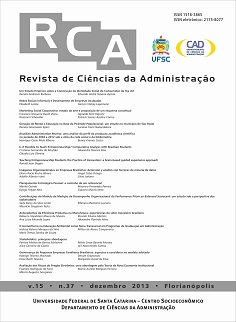The Isomorphism in Environmental Education as a Cross-Cutting Theme in Undergraduate Management Programs
DOI:
https://doi.org/10.5007/2175-8077.2013v15n37p170Abstract
The National Environmental Education Policy determines the inclusion of environmental education at all levels of education as a continuous cross-cutting model, prohibiting its use as a specific discipline. The theoretical perspective is based on isomorphism applied to the transverse mode in Higher Education Institutions – HEI, seeking to identify the mechanisms that drive the change of their behavior, uncovering what forces promote the incorporation of environmental education in the disciplines as a crosscutting theme. The methodology used is quantitative-qualitative and uses a case study at four HEIs with Degree in Administration. We conclude that coercive isomorphic pressure, by society, and rules, linked to professional practice, contribute mostly to the institutionalization of environmental education in the curriculum. Social demands for training the administrator with environmental knowledge is the strongest factor in this process.Downloads
Published
How to Cite
Issue
Section
License
The author must ensure:
- that there is complete consensus among all co-authors to approve the final version of the paper and its submission for publication.
- that their work is original, and if the work and/or words of others have been used, these have been duly acknowledged.
Plagiarism in all its forms constitutes unethical publishing behavior and is unacceptable. RCA reserves the right to use software or any other methods of plagiarism detection.
All submissions received for evaluation in the RCA journal are screened for plagiarism and self-plagiarism. Plagiarism identified in manuscripts during the evaluation process will result in the submission being archived. In the event of plagiarism being identified in a manuscript published in the journal, the Editor-in-Chief will conduct a preliminary investigation and, if necessary, retract it.
Authors grant RCA exclusive rights of first publication, with the work simultaneously licensed under the Creative Commons (CC BY) 4.0 International License.

Authors are authorized to enter into separate, additional contractual arrangements for the non-exclusive distribution of the version of the work published in this journal (e.g., publishing in an institutional repository, on a personal website, publishing a translation, or as a chapter in a book), with an acknowledgement of its authorship and initial publication in this journal.
This license grants any user the right to:
Share – copy, download, print, or redistribute the material in any medium or format.
Adapt – remix, transform, and build upon the material for any purpose, even commercially.
According to the following terms:
Attribution – You must give appropriate credit (cite and reference), provide a link to the license, and indicate if changes were made. You may do so in any reasonable manner, but not in any way that suggests the licensor endorses you or your use.
No additional restrictions – You may not apply legal terms or technological measures that legally restrict others from doing anything the license permits.


